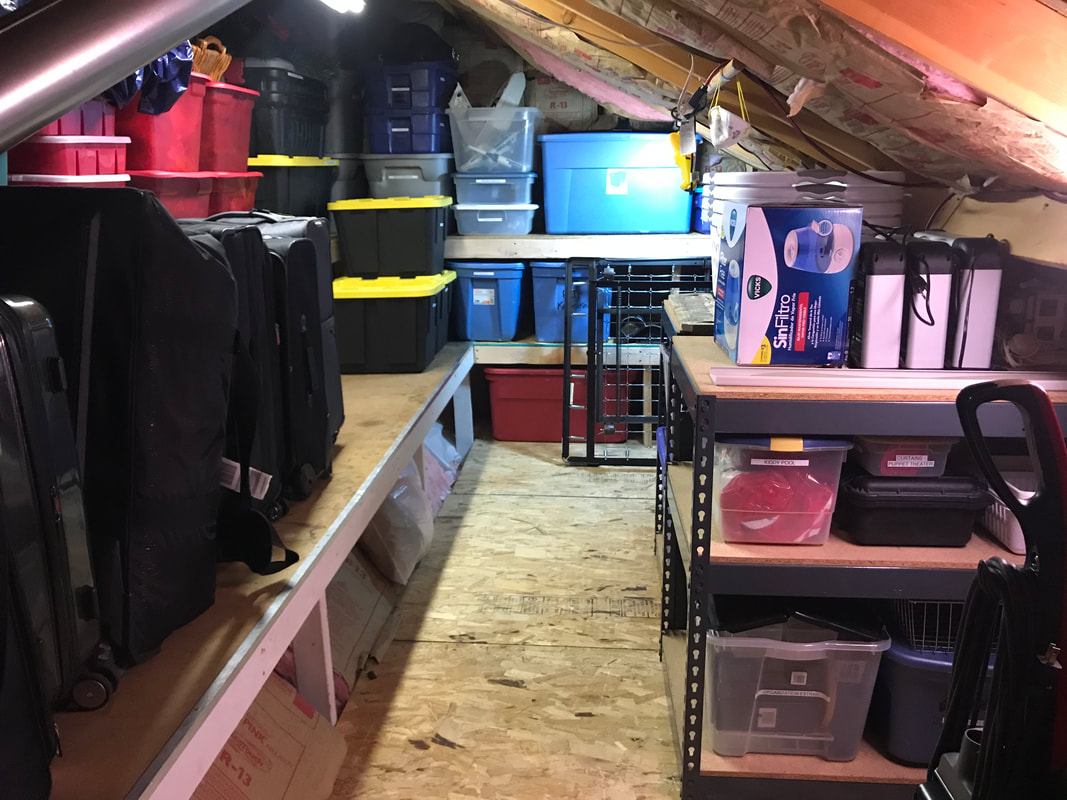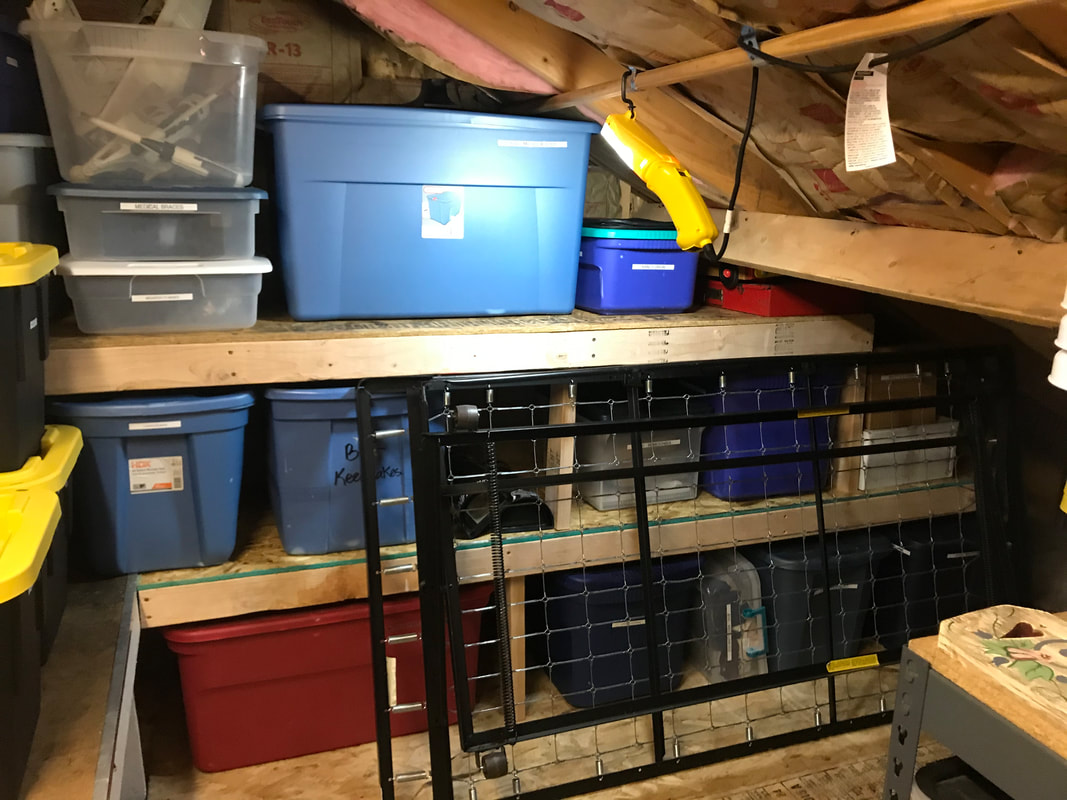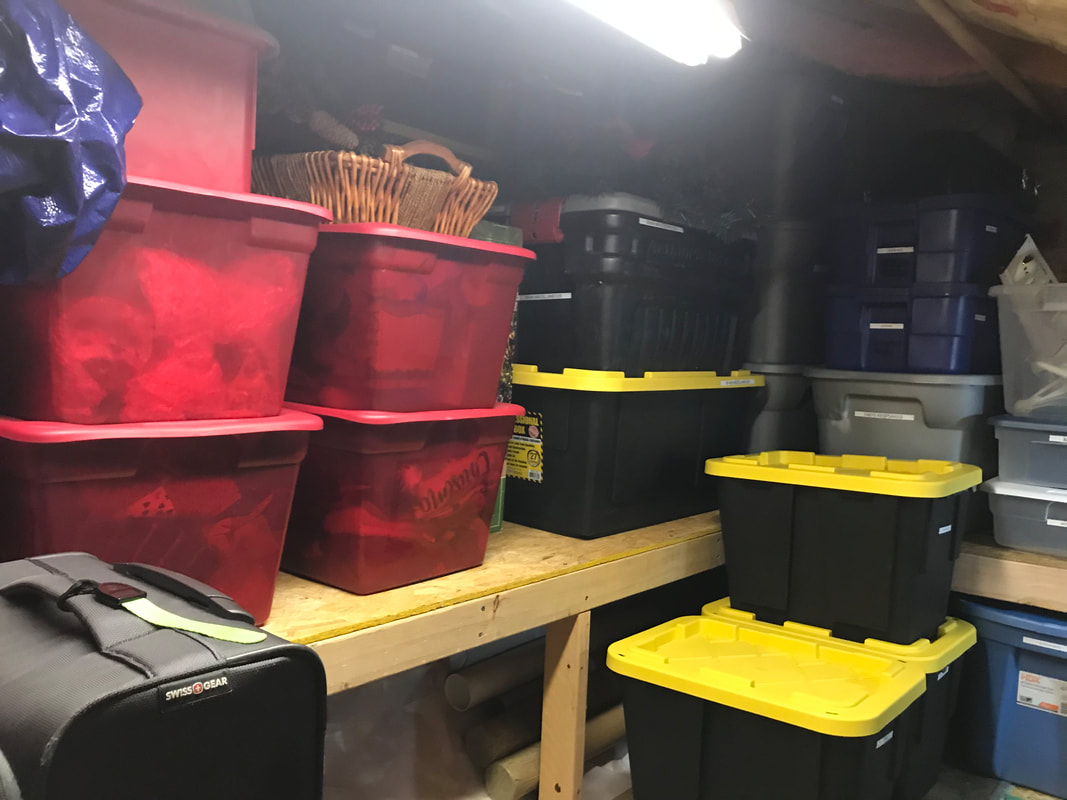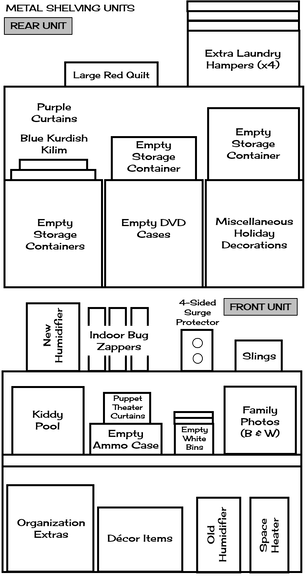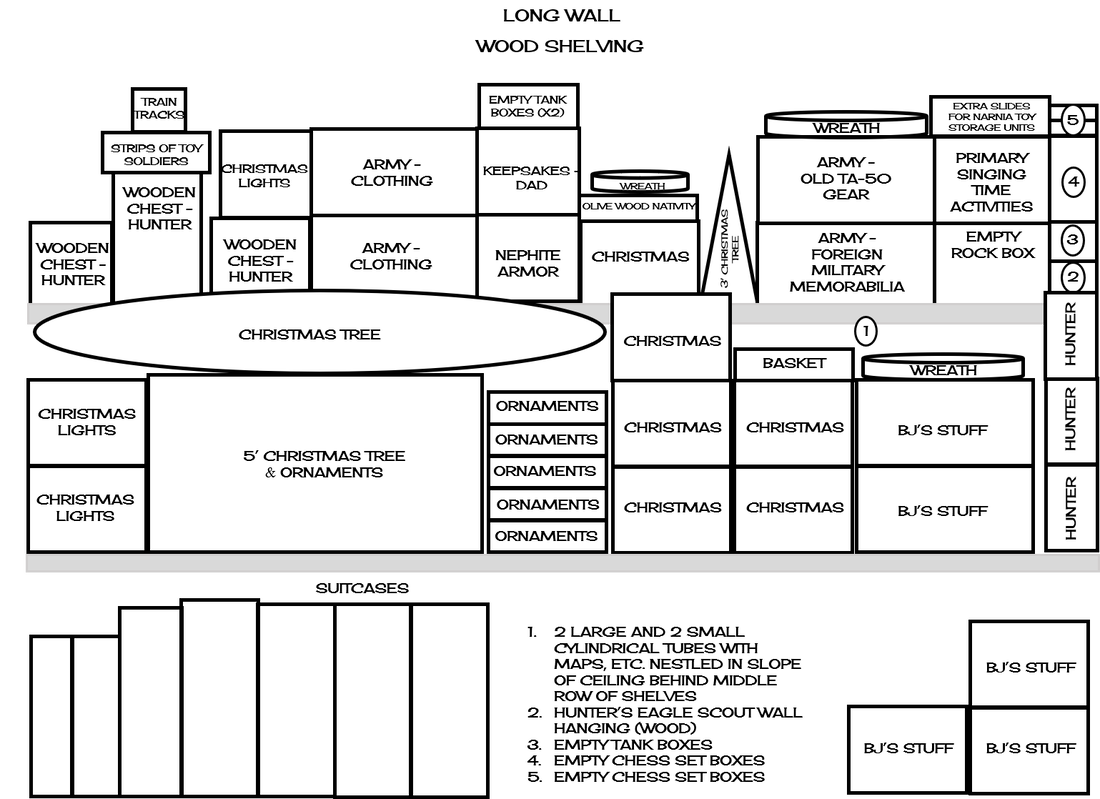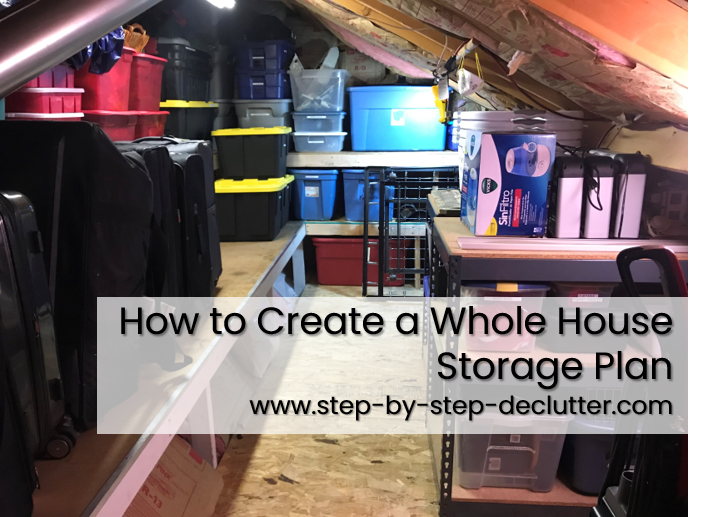|
|
How to Create a Whole House Storage Plan |
|
Storage comes in many forms. Some storage is designed to be accessed multiple times a day. Other storage is meant to be accessed regularly. Long-term storage, on the other hand, is for items that are infrequently used. It's long-term storage that I want to focus on here.
When it comes to long-term storage, most of us have it stashed in various areas of our homes. There may be some in the attic, some in the basement, some in the guest room closet, some under a bed (or many beds!), and so forth. Remembering where you placed everything can be challenging. To keep track of where things are stored in your home I recommend creating a whole house storage plan. It's easy to do, and it saves time and frustration searching for things.
When it comes to long-term storage, most of us have it stashed in various areas of our homes. There may be some in the attic, some in the basement, some in the guest room closet, some under a bed (or many beds!), and so forth. Remembering where you placed everything can be challenging. To keep track of where things are stored in your home I recommend creating a whole house storage plan. It's easy to do, and it saves time and frustration searching for things.
What is a Whole House Storage Plan? |
|
A whole house storage plan is a detailed record of what's stored where in your home. It's not difficult to establish, but it does take some planning and some time, and it will most likely involve some rearranging. I think of it as a four step process.
Creating a Whole House Storage Plan |
|
Step 1 - Identify Potential Storage Areas
Even if you've been living in your home for thirty years, the best way to begin the process of creating a whole house storage plan is to identify the potential storage areas in your home. It can be helpful to categorize these in terms of primary and secondary storage areas.
I'll use my own home as an example. Our primary long-term storage spaces are:
Our secondary long-term storage spaces include:
Even if you've been living in your home for thirty years, the best way to begin the process of creating a whole house storage plan is to identify the potential storage areas in your home. It can be helpful to categorize these in terms of primary and secondary storage areas.
I'll use my own home as an example. Our primary long-term storage spaces are:
- a 5 x 12 storage room (basement)
- a narrow sloped closet under the stairs (basement)
- a 2-car garage (main floor)
- an attic space with slanted ceiling (2nd floor)
- a 10' x 10' shed (outdoor)
Our secondary long-term storage spaces include:
- 3 standard sized bedroom closets
- 2 walk-in bedroom closets
- under bed space in five bedrooms
- a set of deep and wide laundry room cupboards (upper & lower)
- space above the laundry room cupboards
Step 2 - Make a Plan
Once you've identified the potential storage spaces in your home, it's time to decide what gets stored where. Consider the following when determining the best location to store specific items or types of items.
Once you've identified the potential storage spaces in your home, it's time to decide what gets stored where. Consider the following when determining the best location to store specific items or types of items.
- Temperature Control - Items that are sensitive to fluctuations in temperature should be stored in areas of your home that maintain a constant temperature. Identifying what these items might be may require a little thought, as demonstrated in the story below.
|
|
An Unpleasant Surprise |
|
Many years ago when we were living in Vermont, our Christmas decorations included a large snow globe with a nativity scene inside. Our home was built in 1820, long before storage spaces were in vogue. As a result, the only place to put long-term storage items was in the 'garage'. I use the term garage loosely as the space was really designed to accommodate a horse and buggy, not a modern vehicle, and it had no climate control. Long story short, the water in the snow globe froze and expanded during the winter, breaking the glass. When it thawed, it leaked all over the contents of the box which became moldy. Needless-to-say, I had a nasty surprise when I opened the box the following December. Everything inside had to be thrown out (to include my children's Christmas stockings). It never even occurred to me that such a thing could happen, but as soon as I saw it I knew how and why it had. It was an unpleasant reminder of the importance of temperature control for storing certain items.
- Ease of Access - Store the things you use consistently (like camping gear or sports' equipment) in places that you can access easily. If your space requires you to stack items, this means most frequently used items at the front and on the top, and least frequently used items at the back near the bottom.
- Purpose - It's always best to store things as close as possible to the place where you will use them. Thus the garage is a better place than the attic to store camping gear as you can load and unload things easily when you want to use them.
- Value - Another important, but often overlooked, consideration when planning long-term storage is the actual value of the items being stored. By value, I'm not referring to the cost, but rather the worth you personally place on a particular thing. As part of your planning and rearranging, ask yourself if you even need, use, or want all of the items you're storing. If the answer is no, then don't bother designating space for them to reside. Too often we keep things simply because they belong to us. Storage space is too precious a commodity to waste it on stuff that doesn't serve an identifiable purpose in your life.
|
|
Our Plan |
|
My husband and I have created and implemented a whole house storage plan for our home. It took a few months to implement fully, but we're very happy with the results. Here is a general outline for the primary storage spaces in our home:
- Shed: yard and gardening tools, lawn mower, potting supplies, and scrap wood
- Garage: automotive equipment and supplies, exercise and sports equipment, camping gear, cold weather clothing (boots, heavy duty gloves, etc.), cleaning supplies, and trash/recycling.
- Basement Storage Room: extra interior paint and painting supplies, home improvement supplies (tiling and plumbing), canning supplies, and long-term food and water storage.
- Closet Under Stairs: serves as a pantry for non-perishable food items we use regularly.
- Attic: keepsakes, Christmas and other holiday decorations, luggage, 2nd floor vacuum. humidifiers, bug zappers, space heater, rotating home decor items, and extra organizational supplies.
Step 3 - Rearrange as Needed
Once you've determined the best place for each type of item to be stored, it's time to put things in their designated places. If you've been in your home for awhile, this may mean doing some rearranging. I know it takes effort, but it's worth it. In our case, we had to wait until the shed was installed to move some things out of the garage and basement storage room, thus freeing up space elsewhere. We also decided to build some shelving in the attic.
Once you've determined the best place for each type of item to be stored, it's time to put things in their designated places. If you've been in your home for awhile, this may mean doing some rearranging. I know it takes effort, but it's worth it. In our case, we had to wait until the shed was installed to move some things out of the garage and basement storage room, thus freeing up space elsewhere. We also decided to build some shelving in the attic.
Step 4 - Make a Record
After everything is in its proper place, there's one last step to complete your whole house storage plan. That is to create a master list, or record, of where things are stored. This is a crucial step in the process because it ensures that everyone will know where to find everything.
A master list can take a couple of different forms. One is a simple list, much like the one I shared above (see "Our Plan"), that identifies which items are stored in each location. For more complex storage spaces in which items are stacked on top of or in front of one another, I recommend creating a map, or floor plan, or elevation of the space. Whatever you call it, they all serve the same purpose: to identify not only what is stored in the space, but also where each item is located within the space.
After everything is in its proper place, there's one last step to complete your whole house storage plan. That is to create a master list, or record, of where things are stored. This is a crucial step in the process because it ensures that everyone will know where to find everything.
A master list can take a couple of different forms. One is a simple list, much like the one I shared above (see "Our Plan"), that identifies which items are stored in each location. For more complex storage spaces in which items are stacked on top of or in front of one another, I recommend creating a map, or floor plan, or elevation of the space. Whatever you call it, they all serve the same purpose: to identify not only what is stored in the space, but also where each item is located within the space.
Our attic (pictured above) is a rather large and complex storage space, so I created a storage floor plan and elevations to keep track of where things are located. I started by making a rough sketch of the space. Then I went into PowerPoint and created a more detailed, easier to read version using basic shapes and text boxes. You can be as simple or as elaborate as you like. Your map/floor plan doesn't have to look anything like mine. It just needs to make sense to you and anyone else who may need to locate items.
Below are some additional images of my attic space and the floor plan and elevations I created to document the location of items within the space.
Below are some additional images of my attic space and the floor plan and elevations I created to document the location of items within the space.
|
|
Thoughts on Labeling |
|
When storing items long-term it's important to label containers carefully. You don't want to have to open every box within the space to find what you're looking for - and I can almost guarantee that whatever you're looking for is going to be in the last box you open. That's just how that process works. Save yourself a lot of headache and time by indicating clearly on the outside of each container what is contained inside. I recommend labeling both the front of the container and one or both sides. This way it doesn't matter how the box is oriented in the space, you'll be able to read the label.
I encourage you to get started today on a whole house storage plan. Not only will it make things easier to find when you need them; it will also help you better utilize the storage space in your home.
Proudly powered by Weebly
